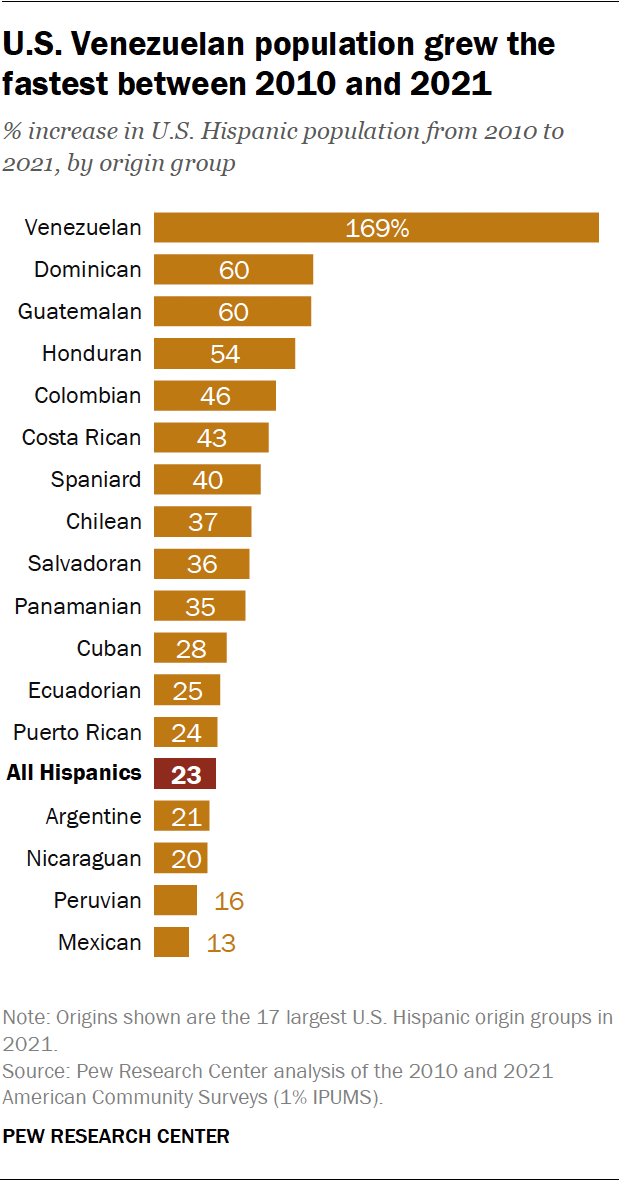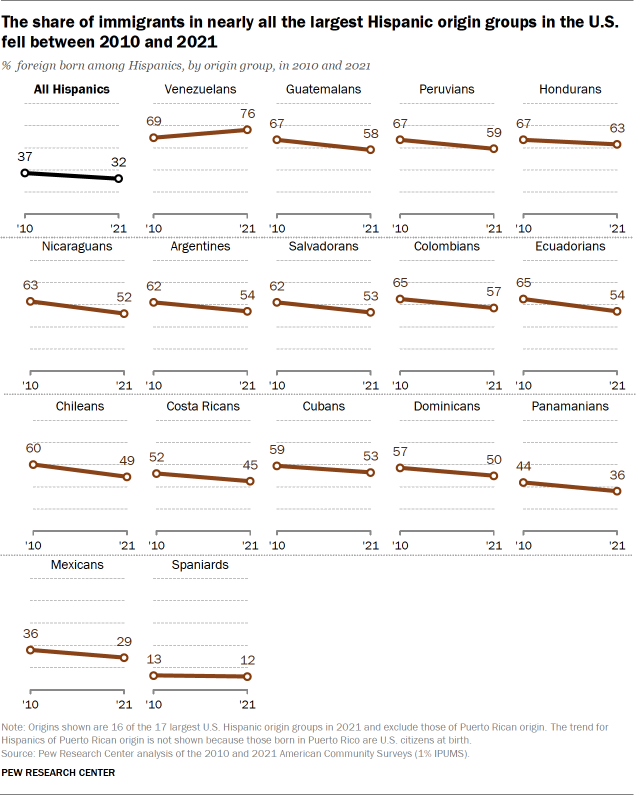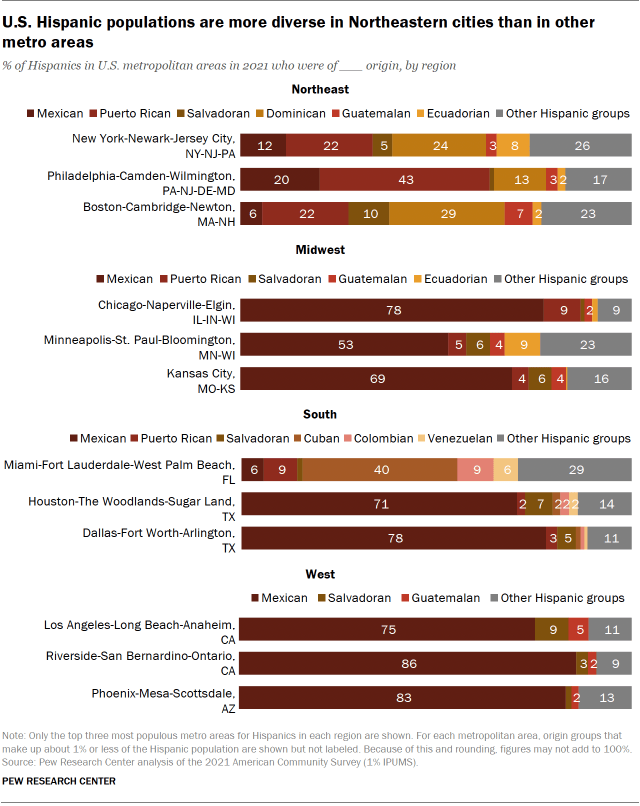This blog post examines the Hispanic population in the United States. It also looks at characteristics for the 17 largest origin groups among U.S. Hispanics: Mexicans, Puerto Ricans, Salvadorans, Dominicans, Cubans, Guatemalans, Colombians, Hondurans, Spaniards, Ecuadorians, Peruvians, Venezuelans, Nicaraguans, Argentines, Panamanians, Chileans and Costa Ricans.
This post uses Pew Research Center tabulations of the U.S. Census Bureau’s 2010 and 2021 American Community Survey (ACS), accessed through the Integrated Public Use Microdata Series (IPUMS) provided by the University of Minnesota.
Due to differences in how IPUMS and the Census Bureau adjust income data and assign poverty status, data in this post may differ from Census Bureau publications.
“U.S. born” refers to individuals who are U.S. citizens at birth, including people born in the United States, Puerto Rico or other U.S. territories, as well as those born elsewhere to parents who are U.S. citizens. “Foreign born” refers to individuals who are not U.S. citizens at birth and is used interchangeably with “immigrant.”
Additional information about all U.S. Hispanics and the 17 largest Hispanic origin groups can be found in our Hispanic statistical portrait.
In 2022, there were 63.7 million Hispanics living in the United States. The U.S. Hispanic population has diverse origins in Latin America and Spain.
Recently, the origins of U.S. Hispanics have begun to shift as patterns of immigration from Latin America change. Notably, the number of Mexican immigrants living in the U.S. has fallen as the number of immigrants who identify as Dominican, Venezuelan, Guatemalan, Honduran, Salvadoran or with another Hispanic origin has grown.
Here are 11 facts about the U.S. Hispanic population, its origin groups and how those groups differ from one another. This analysis is based primarily on data from the U.S. Census Bureau’s 2021 American Community Survey.
Eight Hispanic origin groups had at least 1 million people living in the U.S. in 2021. The five largest Hispanic populations in the U.S. by origin group were Mexicans (37.2 million), Puerto Ricans (5.8), Salvadorans (2.5), Dominicans (2.4) and Cubans (2.4). The other three origin groups with populations over 1 million were Guatemalans (1.8 million), Colombians (1.4) and Hondurans (1.1).
Venezuelans, Dominicans and Guatemalans are the fastest-growing Hispanic origin groups. Between 2010 and 2021, the Venezuelan population in the U.S. increased by 169%, from 240,000 to 640,000. This was by far the fastest growth rate among Hispanic origin groups. Dominicans and Guatemalans had the next-fastest growth rates at 60% each.

In contrast, Mexicans, the largest Hispanic origin group, had the slowest growth rate, at 13%.
However, the Mexican-origin population added a larger number of people than any other origin group – 4.3 million – from 2010 to 2021. The next-largest increases were:
- Puerto Ricans: 1.1 million
- Dominicans: 910,000
- Guatemalans: 660,000
- Salvadorans: 660,000
The share of Hispanics in the U.S. who speak English proficiently has increased. In 2021, 72% of U.S. Hispanics ages 5 and older either spoke only English at home or spoke English very well, up from 65% in 2010. During that time, both U.S.-born and immigrant Hispanics became more proficient in the language. The share of U.S.-born Hispanics who were proficient grew from 88% to 91%, and the share among immigrant Hispanics grew from 32% to 38%.
In 2021, Spaniards (95%), Panamanians (87%) and Puerto Ricans (83%) had the highest shares of English proficiency. Hondurans (47%), Guatemalans (51%), Venezuelans (56%) and Salvadorans (56%) had the lowest shares.
Immigrants are a declining share of the U.S. Hispanic population. About 0ne-third (32%) of all U.S. Hispanics were immigrants in 2021, down from 37% in 2010. U.S. births to Hispanic parents outpaced the arrival of new immigrants in that span. As a result, the U.S.-born Hispanic population grew by 10.7 million while the immigrant population grew by 1.1 million.
Immigrants comprised a smaller share of nearly all Hispanic origin groups in the U.S. in 2021 than they had in 2010. The sharpest decline was among Hispanics of Ecuadorian and Nicaraguan origin, by 11 percentage points each. Venezuelans were the exception: The immigrant share rose from 69% to 76%.

The vast majority of U.S. Hispanics are U.S. citizens. About 81% of Hispanics living in the country in 2021 were U.S. citizens, up from 74% in 2010. U.S. citizens include people born in the U.S. and its territories (including Puerto Rico), people born abroad to American parents, and immigrants who have become U.S. citizens through naturalization.
Among Hispanic origin groups, virtually all Puerto Ricans are U.S. citizens. Spaniards (95%), Panamanians (90%), Cubans (82%) and Mexicans (81%) have some of the highest citizenship rates, while Hondurans and Venezuelans (51% each) have the lowest rates.
Most Hispanic immigrants have lived in the U.S. for at least a decade. Nearly four-in-five Hispanic immigrants (78%) have lived in the U.S. for more than 10 years, up from 64% in 2010. Panamanian (87%) and Mexican (86%) immigrants are the most likely to have lived in the U.S. for more than 10 years.
On the other hand, Venezuelan immigrants (62%) and Honduran immigrants (48%) are the most likely to have lived in the U.S. for 10 years or less.
The makeup of the U.S. Hispanic population varies widely across major metropolitan areas. In the U.S. overall, Mexicans make up the greatest share of U.S. Hispanics at 60%. No other origin group makes up even 10% of U.S. Hispanics. But these shares differ dramatically in specific metropolitan areas.
The metro areas in the Midwest, West and South with the largest Hispanic populations tend to be predominantly Mexican, with notable exceptions Miami and Orlando. About three-quarters of Hispanics in the Chicago (78%) and Los Angeles (75%) areas identify as Mexican, as do 71% in the Houston area.
On the other hand, Hispanic populations in Northeast metro areas tend to be more diverse. For instance, no origin group makes up more than 30% of the New York and Boston metro areas’ Hispanic populations.
Other metro areas across the country stand out as distinctive Hispanic enclaves. For example, Puerto Ricans make up 43% of Hispanics in the Orlando, Florida, area; Cubans make up 40% of Hispanics in the Miami area; and Salvadorans account for 31% of Hispanics in the Washington, D.C., area. Each of these origin groups is the largest in its respective metro area.

The U.S. Hispanic population is aging but remains younger than Americans overall. The median age of U.S. Hispanics increased from 26.3 years in 2010 to 29.5 years in 2021. Yet they remained much younger than the overall U.S. population, which had a median age of 37.8 in 2021. The median age of U.S.-born Hispanics was just 21.0 years compared with 44.5 among immigrant Hispanics.
Among U.S. Hispanics, Cubans and Argentines had the highest median ages in 2021, at 40.0 and 38.5 years, respectively. Guatemalans (26.6 years) and Hondurans (26.9) were the youngest origin groups.
Some Hispanic groups aged more than the overall U.S. Hispanic population between 2010 and 2021. The median ages of Puerto Ricans and Venezuelans living in the U.S. each rose by more than four years, from 26.8 to 31.0 years and 31.3 to 36.0 years, respectively. In contrast, Hondurans’ and Spaniards’ median ages fell from 27.4 to 26.9 and from 34.6 to 34.2, respectively.
The share of U.S. Hispanic adults with a bachelor’s degree is growing. One-in-five Hispanics ages 25 and older had a bachelor’s degree or higher in 2021. While this share was less than that of the overall U.S. population (38%), it was up from 13% of Hispanic adults in 2010.
Among Hispanic origin groups, Venezuelans (57%) and Argentines (46%) had the highest shares of people 25 and older with a bachelor’s degree or more. Guatemalans (11%) and Salvadorans (13%) had the lowest shares. Notably, the share of people with at least a bachelor’s degree increased for every Hispanic origin group between 2010 and 2021.
Household incomes vary widely among Hispanic groups. The median household income for Hispanics in the U.S. in 2021 was $59,000, below the overall U.S. median of $67,800. Among Hispanic origin groups, Argentines had the highest median household income at $80,000, while Hondurans and Dominicans had the lowest median household income at $50,000 each.
Homeownership rates are rising among Hispanic households. Hispanic homeownership rates in the U.S. rose slightly between 2010 and 2021, from 47% to 51%. However, those rates trailed the rate for all U.S. households, which was 65% in both years.
The origin groups with the highest homeownership rates in 2021 were Spaniards (63%) and Argentines (62%). They were about twice as likely to own their homes as Dominicans (31%) and Hondurans (31%), the groups with the lowest rates of homeownership.
Of the 17 Hispanic origin groups in this analysis, 11 saw their homeownership rates increase by at least 2 percentage points between 2010 and 2021. Panamanians’ rates increased by 7.8 percentage points, the largest gain of any group.
For more information on Hispanics in the 50 states and the District of Columbia, read Pew Research Center’s detailed fact sheets. The fact sheets describe demographic, employment and income characteristics for the 17 largest Hispanic origin groups.
Note: This is an update of a post originally published Sept. 16, 2019.






